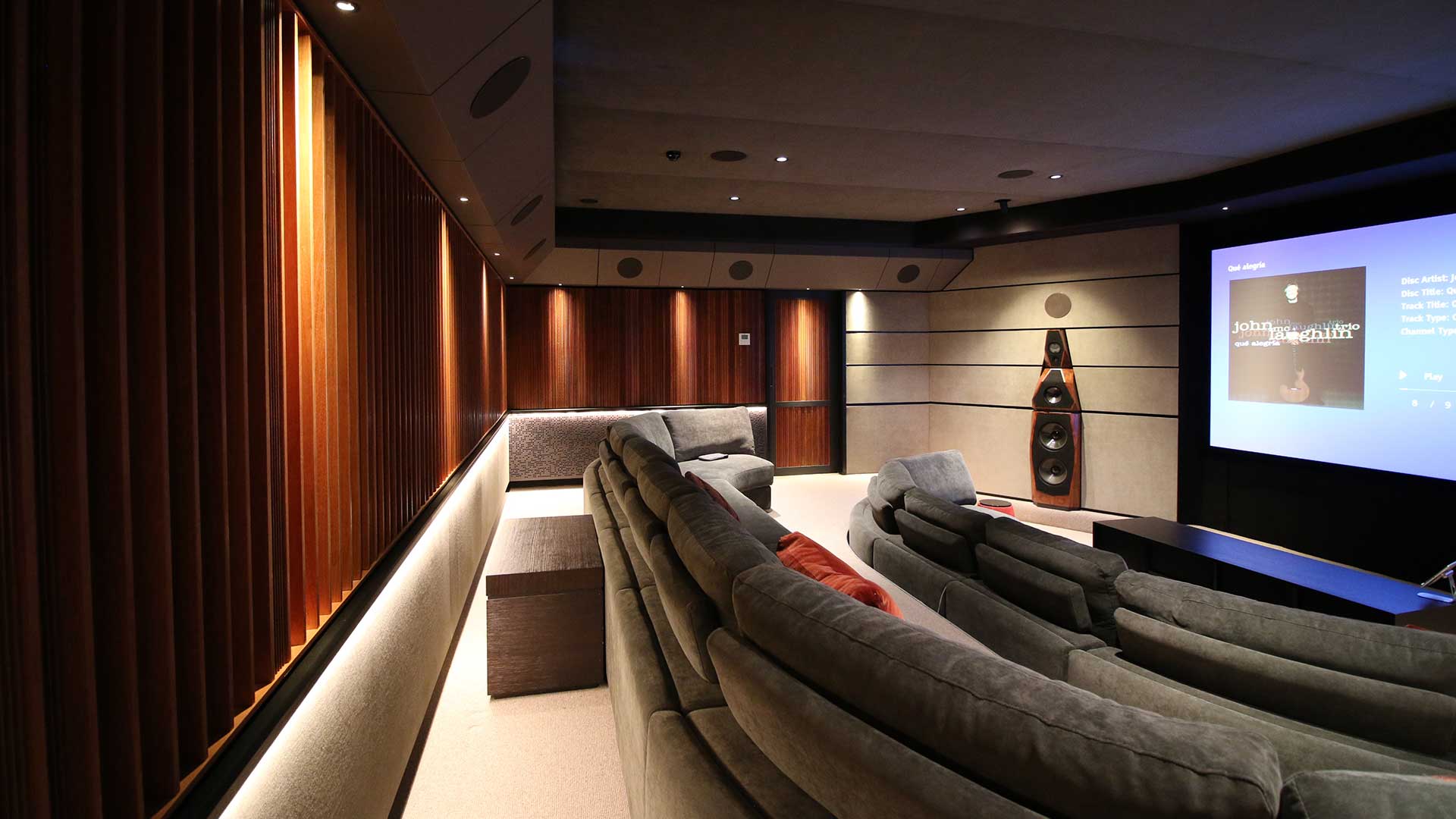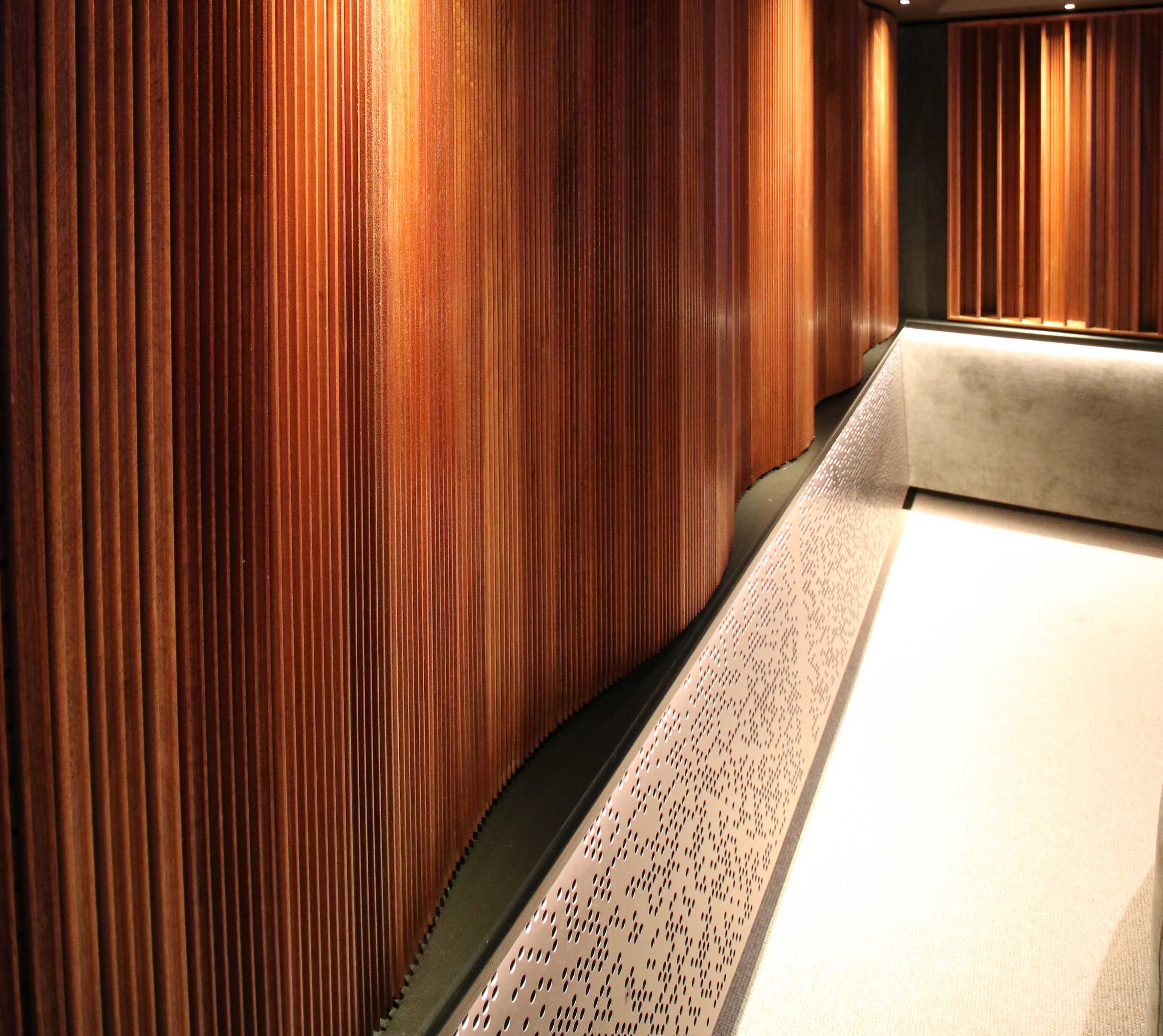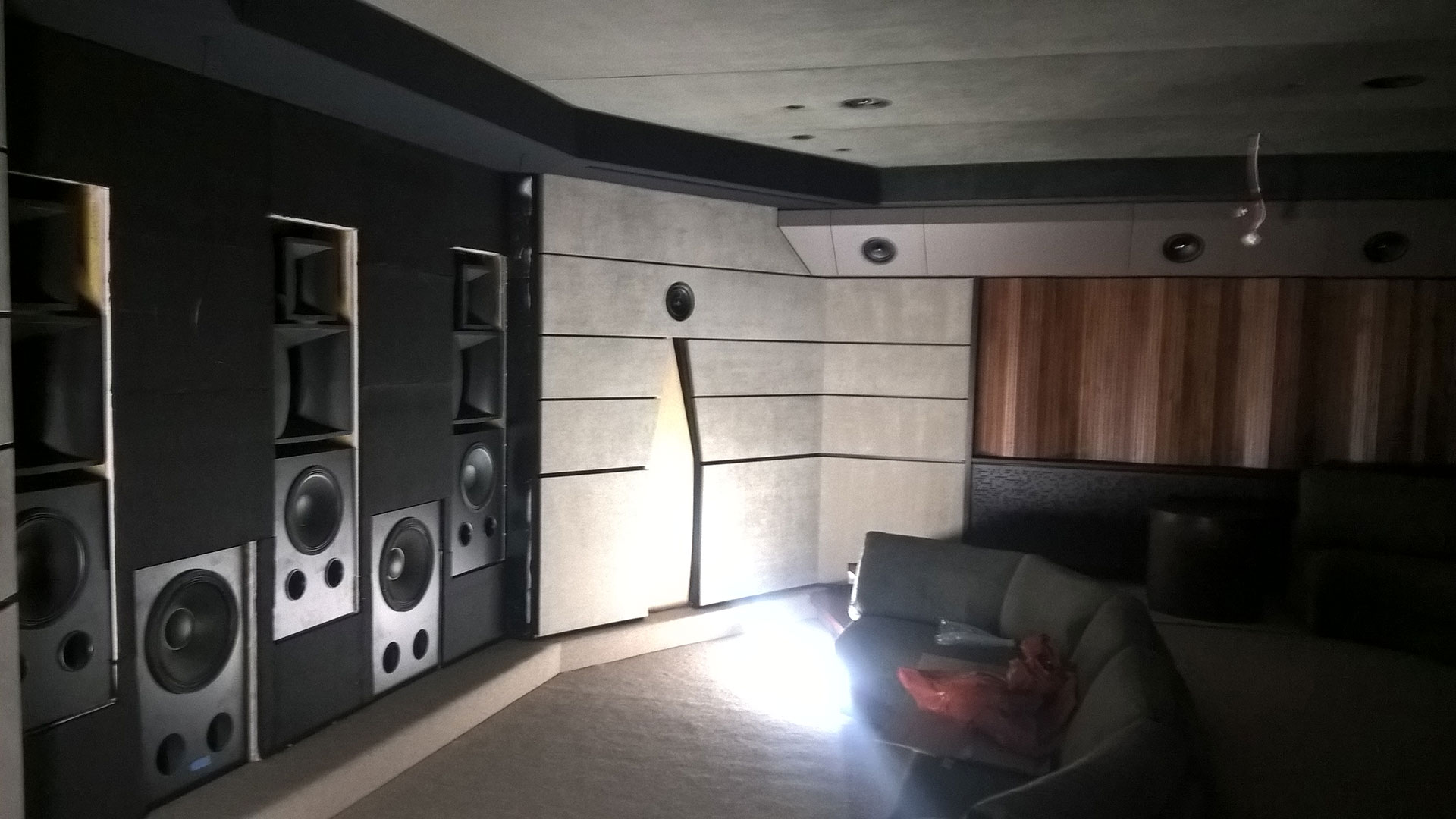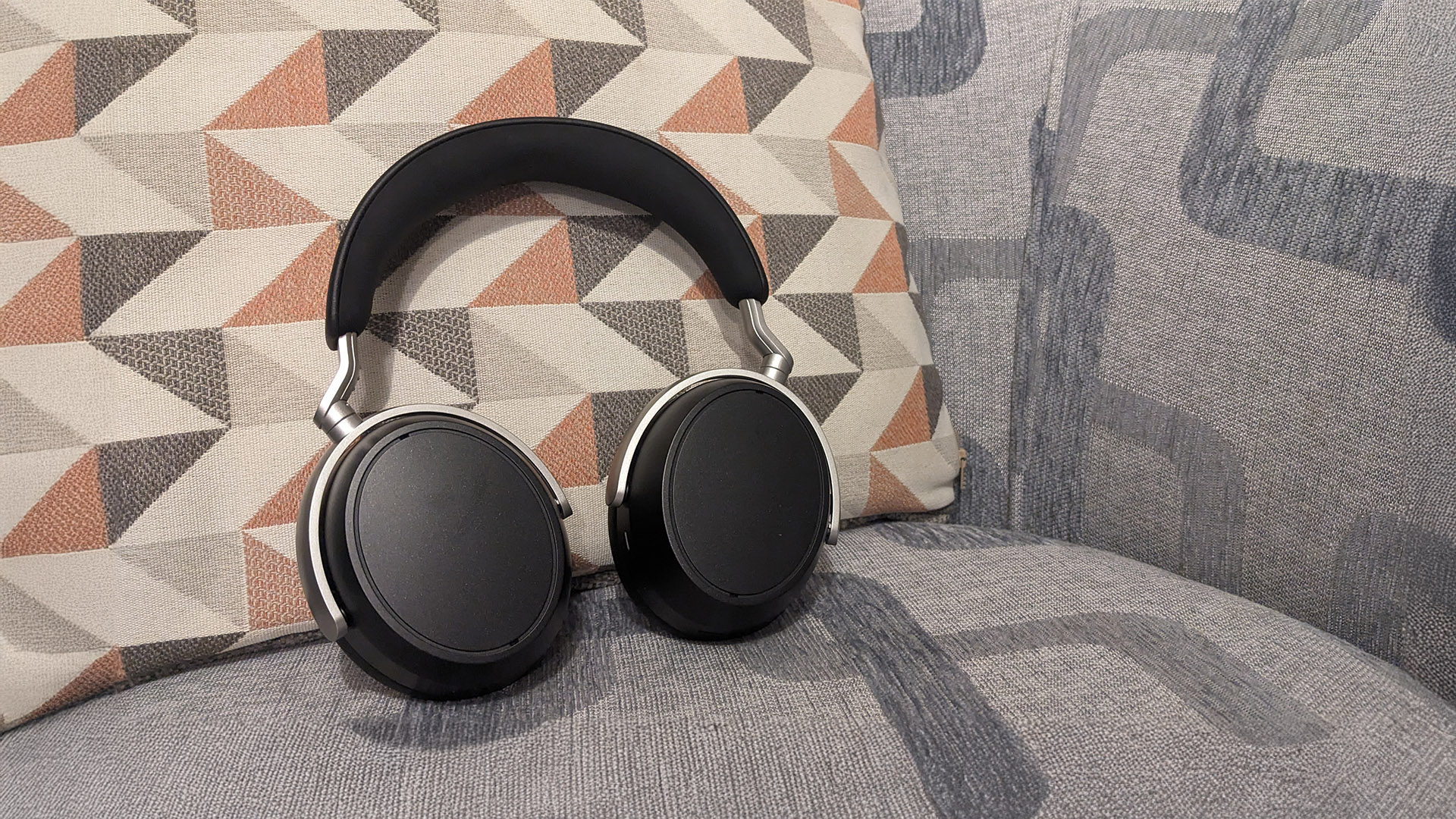Aussie home theatre: One room - two systems
Abacus Acoustic delivers an extraordinary room with full semi-pro movie sound flanked by a high-end stereo system
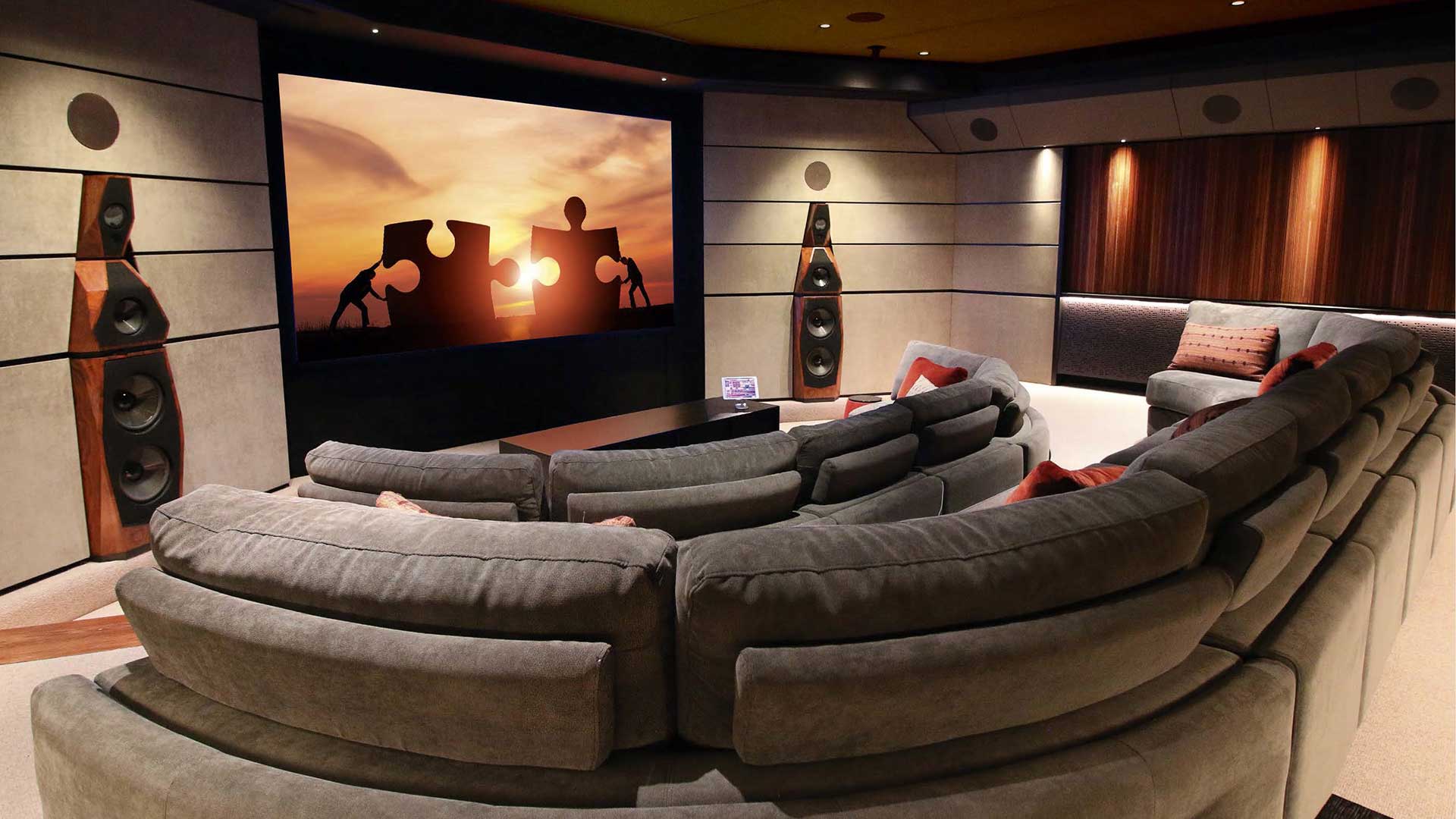
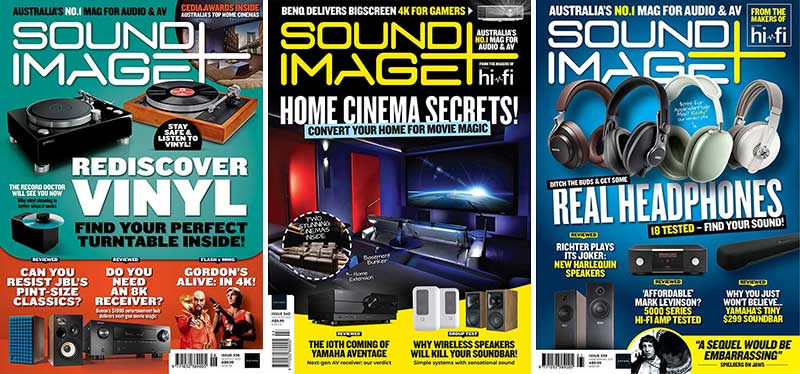
This article originally appeared in Sound+Image magazine, one of What Hi-Fi?’s Australian sister publications. Click here for more information on Sound+Image, including digital editions and details on how you can subscribe.
"It’s pure Bauhaus, what you’re sitting in here – the ‘Form Follows Function’ maxim,” says design engineer Ian McGrath as he leads us through this wildly impressive room. “The functions here are sound and image, and the room must provide as near as possible the final mixed and mastered movie as laid down by its creators. The design development of a cinema needs to follow that edict if it’s to reach what’s bandied about as the ‘immersive experience’.”
Yet this room is not only a fully-immersive 7.2.4 Atmos home cinema; there is a separate high-end stereo system in the same space.
“Yes, it’s a hybrid room”, he explains. “I don’t think what we’re doing here has ever been attempted in quite the same way, to have such a high-end stereo monitoring room and cinema in the one space. It was certainly a high-wire act in design engineering terms. But I’ve worked in both those worlds: I’ve been been delivering film preview and recording studios for some time now. So I know that to achieve that there are rules of the game – in the room acoustics, how the speakers fire, how accurate and natural the audio and video system, even room colours and décor affect the contrast ratio and the colour depth.”
Getting the room right
“Then there is the budget allocation – equipment versus room build,” Ian continues. “It was clear to me there would be many competing budgets within the whole house construction, and it was just not an option to have ultra-expensive equipment firing into a financially-handicapped under-performing room that conflicted with the bespoke interiors within the rest of the house. I’d say we got the balance just right for this project.”
As you can see, it is certainly a spectacular room, built into a ground-floor annexe from the foyer of an expansive bespoke harbourside residence in Sydney. McGrath had input into the isolation of the four residential levels from the car lift and passenger lift, ensuring a quiet living experience in each area. And one of his first tasks was to get the originally-planned cinema location moved.
“The shell was originally on the other side of the building, tucked in under the car lift,” he explains. “With my head of CAD, Hannah Evans, I submitted several different layouts until a consensus was met – there was enough flexibility within the project group to allow the integration of a well-orientated shell structure. The game can be won or lost in the container shell’s volume and proportions.”
And Ian McGrath is very clear on the importance of getting the room right.
The latest hi-fi, home cinema and tech news, reviews, buying advice and deals, direct to your inbox.
“As soon as the sound leaves the speaker coil, the room has command of it,” he says. “So that’s the challenge – acoustically you need to provide a neutral environment. I’ve heard rooms with serious defects in the acoustic treatment and functions push an expensive room optimiser to well beyond its limits of control. High sound pressure level episodes delivered to small spaces present quite a demanding load on the room’s ability to remain in a sonically neutral state. The loss of detail under those loads can be significant.
"And this all goes back to recording studio technology in the 1960s. The Beatles stopped touring because their live amplifiers and speaker systems were too inefficient to get over the screaming crowd. They couldn’t hear themselves play, their musicianship went down the hole, so they pulled off the road – and we’re talking megabucks, a lot of money. So Altec Lansing and JBL started producing very efficient live gear, amplifiers and speakers, and the next wave was Led Zeppelin, Deep Purple, and so on, who were touring 80% of the time, recording 20%. And they wanted that live sound on the record.
“So they haul in all this loud powerful equipment and the room acoustics – which were still a là 1930s/1940s – would collapse and saturate under the high SPLs.
“Then in 1967 an engineer from Altec Lansing was given a workshop beneath the Record Plant in New York, and one day he took their studio monitors up on the roof and found they sounded much better there, and he came up with the concept of free field acoustics. He overcooked it a bit, as the need for a live rhythm track recording straight off the floor demanded high levels of attenuation across the floor and his control rooms had a live front end with extremely dead deep back walls and a screaming horn loaded into a flush-mounted dual 15-inch speaker box. But it was good for the times – big albums came out of it, and he built studios all round the world so people could record in New York, take their master tapes to Paris and have continuity of the recording environment.
“Then by the early ’80s we had the Techron TEF System 12 for measuring Time-Energy-Frequency measurements. That drove a new path of acoustic development in small monitoring rooms as it gave us several more dimensions of complex sound-fields beyond what the third-octave analyzer could deliver. It allowed us to really ‘see’ what was happening, and the big monster in the room was sub bass, which can wipe out your hard work all too easily. Loss of containment and control of the low frequency component in a room leads to masking of the upper midrange to the high frequency component of the sound field. That can significantly affect speech intelligibility in a cinema, and then the remedy is heavy EQ or DSP... which can take you further away from the original film mix. This cinema has the chalk-on-the-blackboard effect even in the middle of a full-blown all-subs-up 110dB episode. Suspense in cinema relies on dynamic range and transient response in the room – it’s there to scare when the dinosaur appears!”

Twin systems
The speakers behind the cinema screen are akin to the Krix Theatrix model from the Series X range, the South Australian company’s highest level of domestic speaker, derived from the professional models it installs in cinemas around the world. Through Ian’s relationship with Scott Krix, an unusual level of customisation was applied.
“I got to know Scott Krix when I was working with Greater Union as a consultant in the 1990s,” Ian tells us. “For this project we worked out the peak in the room, which is about 118dB, and he did us a bit of a favour and tweaked the crossovers, the filters in the sub-bass so they weren’t that loud but they were more musical, nice and tightly controlled. So he’s a pal.”
The stereo system is entirely separate, other than control of both systems being combined under the same iPad RTI app. The impressive Avalon Sentinel speakers are mounted on either side of the screen into angled walls that toe them in to the prime listening positions at the centre back of the room. But also, as we can attest, they deliver a monumental yet tonally impeccable musical image if you choose to relax on the front couch down in front of the screen.
We enjoyed two sessions of stereo listening in the room, particularly thrilled by hearing a high-res remaster of Yes’ Heart of the Sunrise driven to reference levels without a hint of hitting the end-stops, perfectly maintaining tone and instrumental separation. For more nuanced performance we enjoyed the Stockfisch high-res recording of Chick Corea’s Children’s Song No.6 by the Blue Chamber Ensemble, hearing depth to the piano we’d never even noticed on our own home system, while its swirling cymbals emerged astoundingly lifelike through the Sentinels. Eva Cassidy’s Fields of Gold, streaming from Deezer, also produced goosebumps (as it should).
“There are two components to the Avalons,” Ian explains. “The normal speaker system has a bass driver, tweeter and midrange driver, and that’s run by the Bryston 14B3 stereo power amplifier. But the Avalons also have their own sub bass speakers, so the stereo signal is distributed through dedicated bass amplifiers, which have crossover networks and you can pick your crossover point. So you’ve got pass filters going on, but there are no tone circuits, it’s very pure — the Oppo accepts a stereo audio feed via a dedicated audio HDMI input from the Marantz’s second zone stereo HDMI feed. That’s fed to the dedicated Sentinel stereo amp configuration.”
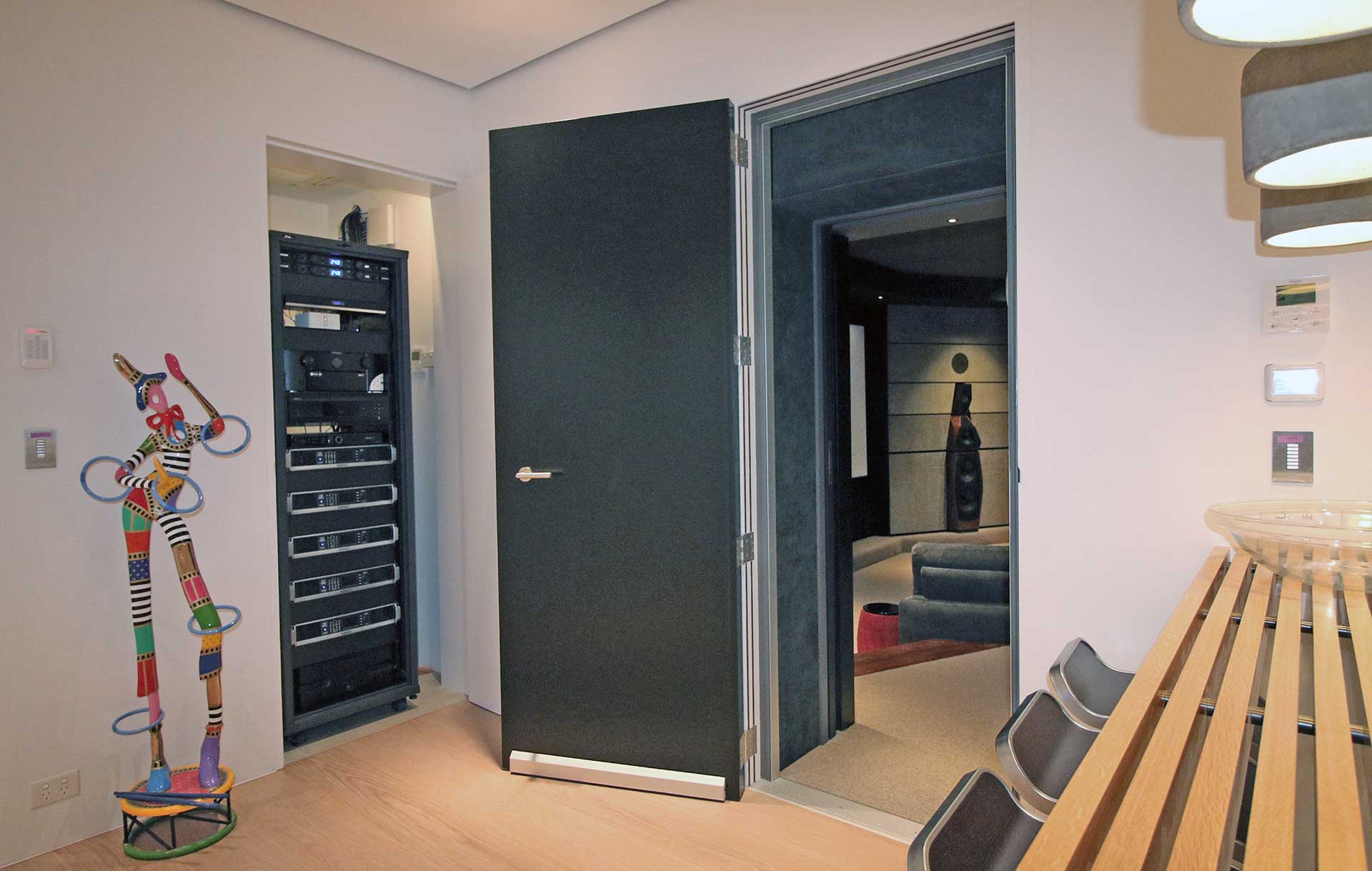
“We picked the QSCs because they’re reliable, and economical in that they’re so mass produced — they’re in cinemas and stadiums everywhere. And they’ve got a lot of DSP in them, though we hardly had to touch it; the cost efficiency and the reliability were the two factors that really won the day there.”
It is what we’d call a 7.2.4-channel Atmos system.
“There are a lot more speakers than that,” says Ian, indicating the surround and ceiling speakers which number 16 in total, all eight-inch Definitive Technology in-wall speakers. “Some of them are ganged together, and there are two 18-inch subs, but yes, 11.2 channels in total.”
We heard both surround music and movies through the system here, and again it proved sonically impeccable, with a notable sense of space within the immersive Atmos soundtracks of Wonder Woman and Max Max: Fury Road, along with complete clarity of dialogue no matter the playback level. Redneck Wonderland from Midnight Oil’s 2017 ‘Armistice Day’ concert sounded solid, lively and dynamic. As for bass delivery, a couple of Dolby demonstration tracks had the room thrumming to a level of sub-bass which was borderline silly, yet without a hint of room distortion. Bass control in a room is crucial, says McGrath, here introducing an interesting analogy.
Sitting in an amplifier
“Designing these small rooms – and by small rooms I mean home cinemas and recording studios and production suites – you’re basically building a custom-made amplifier that people are sitting in. The signals provided to it are via the speakers – the movement of air. And it should be treated with the same considerations as a high-end amplifier, with the application of resistors and capacitors in the right place within the circuit – which is the room – to provide a low noise floor, low distortion and no coloration of the incoming signal that moves through it. And the grail with crossovers is phase coherence and time alignment in the speaker system — that’s the thing speaker designers chase, and they do a lot of compromising to get there.
"We do the same thing in room design, but with each client getting a new ‘amp’! A brand-new custom-made amp, if the right client wants to go that far. And a recording studio has to give them that – no EQ, none of the built systems colouring the program content. That’s the challenge. Flat-panel systems like Gyprock walls and ceilings saturate under high sound pressure level episodes. It’s been measured. The result is lobing into the room of particular frequencies which cast a coloration of the frequencies the lobing is centred at. To avoid added distortion, the shell container needs substantial mass in the wall and floor systems, so as to vibrate as low as possible. It also sets up the internal surface treatments by providing a rigid substrate which prevents further vibration within the surface treatment modules.
“That’s why a room like this has a huge mass to it; its external shell is about 300mm of concrete and brick, and the brick skin is floating. Those materials vibrate at a very low frequency, so you’re actually cleaning the bottom end at the same time, because there’s an energy exchange due to the materials’ mass resonating at very low frequencies – the materials in this case bring bricks and mortar – which also facilitates very low noise break-out and confines the bass energy to the room where you can apply maximum LF control. The owner can come down here and listen to music, or watch a Wallabies v. South Africa game at two or three in the morning and nobody hears him even if he’s running it flat out. This is a seriously high functioning room.”
It’s long been a Sound+Image mantra that an acoustically well-functioning room will provide a far better foundation for an immersive audio experience than a not-so-good room where room correction has been used to hide the defects. Ian agrees.
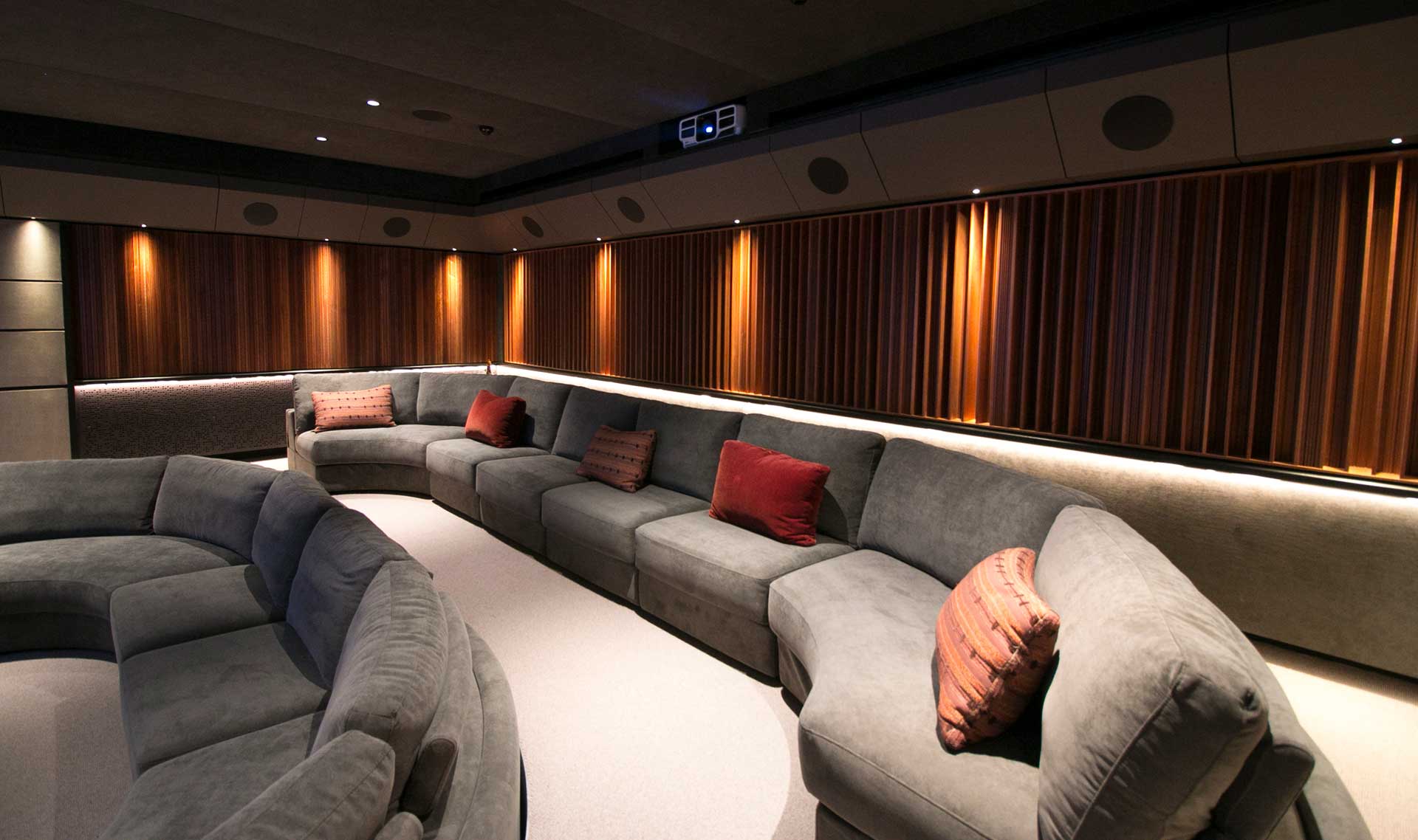
“Even more so with multiple speaker sources populating the perimeter. You want the least amount of equalisation and correction or filtering applied to the signal paths so as to get as close to the originally created content. I’ve experienced rooms where serious amounts of money have been spent on equipment – and in particular cinemas – and the built systems, although interesting or thematically quirky, they fall well short of that immersive experience we’re all seeking. And the introduction of sub-basses into these home environments produces masking, and in a bad out-of-phase room the sub can do a lot of masking of midrange and the upper mids, and all your speech intelligibility gets lost, garbled.
“It’s like in stills photography, if you go into a studio to photograph an object, you use three things – direct light, diffuse light and absorption. You control those elements to get your 3D object onto the camera. It’s the same in acoustics — get those ratios wrong, then if you’ve over-reflected your contrast ratio gets affected, or too much absorption and you lose dimensionality.
“If you over-dampen the room and the sub-bass kicks in, you tend to lose a lot of detail in the mid to high frequencies. Then it’s ‘crank the EQ room correction’ time. You run the risk of hollowing out the original mixed material.”
In the picture above you can see part of the acoustic treatment forming the curve of the room, combining ‘Expo’ panels, Modffractal nested diffusers, and FlutterFree-W, a curved high-frequency diffusing plank – all from RPG Acoustics.
“It’s Manfred Schröeder-based mathematics,” expands Ian. “He was into microwaves and came up with a solution for broadband diffusive units that are in periods and wells, and what you get off it is a spherical wavefront – no key pitches in them. The first-order reflections from these arrays produce a broadband spherical wave front which lifts the reverberant level, which gives depth to the direct signal while applying control of the decay rates. Old cinemas with their ornate walls and ceiling provided a lot of diffusion. Dr Peter D’Antonio – the founder of RPG Acoustics – developed this further into these intelligently practical products. When they’re carefully selected and applied, the RPG units provide a neat fit with broadband control within the envisaged acoustic control systems in the room.”
As for the choice of an acoustically-transparent screen and behind-screen speakers, that was a given.
“Firing the LCR channels through a perforated screen produces what’s called the ‘ventriloquist effect’,” says Ian. “It provides razor-sharp directional information of panning and positioning of effects tracks. It’s used in all commercial cinemas. The nesting of the speakers within a baffle wall – including the sub bass – provides physical time alignment and phase coherence. All these incrementally applied techniques contribute to the overall immersive experience.
“The other thing I prefer is a wider room where possible – again it goes back to the game being won or lost in the shell orientation. I’m not a fan of narrow rooms where the left and right channels are jammed in the corners. If you read the polar plots of speakers, you really have to have the geometry at the side of them correct to allow them to breathe. So I like a bit of spread, a true 2π baffle wall interaction.
“And this is what the project architect Peter Janks recognised early in the process. He picked up that I was practising a very specialised design development process and supported me fully by allowing me the space to apply it to full effect.”
Full story immersion
As you’ve probably noted by now, Ian McGrath likes to tell a story; in our visits and chats we learned almost as much about him as we did about this music room and cinema.
But he ensures that his room designs will deliver the full story as well.
“My design-construct background produces economical straight-forward builds. Clients in the pro audio-visual industry know my work and tend to allow me a greater degree of autonomy to get the necessary results. It’s slightly different in a residential setting – it’s more personal, and I was lucky in this instance to see the client’s previous home. The owner’s brief was: ‘This new home we will be staying in – it has to be the best’.
“So as a tailor, if you will, I could get a feel for what direction they would go re finish, and keep that in mind during design development.
“And I do like doing the complete thing. I remember a Bauhaus exhibition back when I was at design college with a tutor from London who was taught by a Bauhaus. At the exhibition we were sitting on chairs they’d designed, wearing headphones they’d designed, listening to music they’d produced, watching ballets they’d choreographed with everyone wearing costumes they’d designed... And I thought – that’s the go! The complete thing. And of course with that Bauhaus maxim – ‘Form Follows Function’. With that applied to this room, you get exactly what’s bandied about as the ‘immersive’ experience.”
EQUIPMENT LIST & CREDITS
Oppo UPD-205 UHD Blu-ray player
AppleTV gen 4 media player/Foxtel IQ4 cable TV
Marantz AV8802 AV processor/preamplifier
Bryston 14B3 stereo power amplifier
Avalon Sentinel stereo speakers
Krix Series X Theatrix (customised) LCR
Krix Cyclonix (customised) 18-inch subwoofer x 2
Definitive Technology DT8R in-wall speakers x 16
QSC CXD4.2 four-channel amplifiers x 5
Epson EB-L1100UNL projector
Specialty Cinema screen
Furman linear power conditioner
RTI Control touchpanel & app
Middle Atlantic equipment rack
Project Architects: Peter Janks, David Walker
AV Systems Design Schematics: Umow Lai Engineers
Senior AV Consultant: Mal Barnes
Diffusor Systems: RPG Acoustic Inc
Fabric Panels: Acoustica
DESIGN ENGINEER: Ian McGrath, Abacus Acoustic

Jez is the Editor of Sound+Image magazine, having inhabited that role since 2006, more or less a lustrum after departing his UK homeland to adopt an additional nationality under the more favourable climes and skies of Australia. Prior to his desertion he was Editor of the UK's Stuff magazine, and before that Editor of What Hi-Fi? magazine, and before that of the erstwhile Audiophile magazine and of Electronics Today International. He makes music as well as enjoying it, is alarmingly wedded to the notion that Led Zeppelin remains the highest point of rock'n'roll yet attained, though remains willing to assess modern pretenders. He lives in a modest shack on Sydney's Northern Beaches with his Canadian wife Deanna, a rescue greyhound called Jewels, and an assortment of changing wildlife under care. If you're seeking his articles by clicking this profile, you'll see far more of them by switching to the Australian version of WHF.

